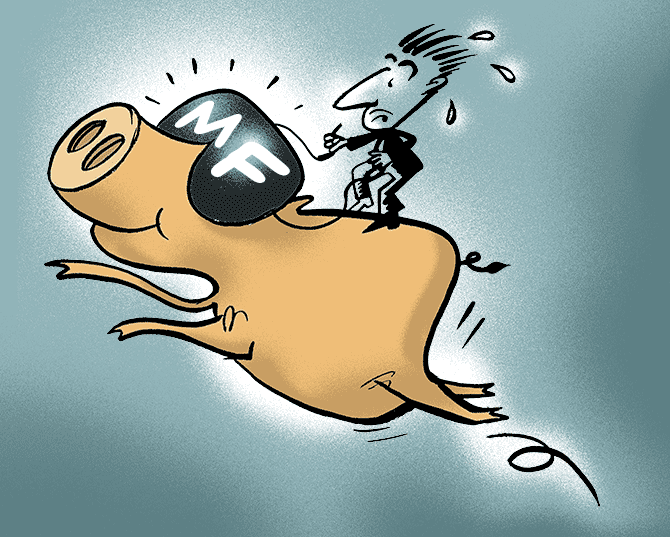 | « Back to article | Print this article |
Investors should continue to remain invested in funds where the duration does not exceed two-three years and the average maturity is not more than four-five years, advises Sanjay Kumar Singh
Illustration: Dominic Xavier/Rediff.com

The Reserve Bank of India (RBI), in its third bi-monthly monetary policy for 2019-20, reduced the repo rate by 35 basis points from 5.75 per cent to 5.40 per cent.
Investors in debt funds need to recalibrate their debt fund strategy to the emerging interest-rate scenario.
The latest rate cut has been prompted by slowing global and domestic economic growth.
"The RBI expects inflation to remain below its target rate of 4 per cent for the rest of the year.
"With inflation under control, it is now looking to support growth, which has weakened considerably," says R Sivakumar, head-fixed income, Axis Mutual Fund.
Experts expect one or at most two rate cuts during the rest of the year.
During his press conference, RBI governor Shaktikanta Das said that the monetary policy committee (MPC) debated whether to cut the repo rate by 25 basis points or 50 basis points.
Fifty basis points, he said, was perceived as too aggressive.
Some experts have interpreted this to mean that there is no scope for significant rate cuts hereafter, and we may at best see one more cut (unless the economy weakens further).
Others differ.
"With inflation expected to remain benign, I see scope for two rate cuts," says K. Joseph Thomas, head of research, Emkay Wealth Management.
"Let us now turn to how investors should go about building their debt fund portfolios after the policy.
"Experts say that the bulk of an investor's portfolio should remain in shorter-term products.
"Yields at the shorter end of the curve offer substantial value. Investors should continue to remain invested in funds where the duration does not exceed two-three years and the average maturity is not more than four-five years," says Sivakumar.
Over the past one year, long-duration and gilt funds have given high double-digit returns.
Nonetheless, experts do not suggest investing in these categories.
One reason is that they tend to be very volatile.
While investors can do well in them if they invest for five years or more, they could also see negative returns in years when rates are rising.
Moreover, the trend of falling yields could reverse.
"In the past 10 years, we have seen that whenever the 10-year government bond yield falls below 6.5 per cent, the trend tends to reverse within a short period of time," says Thomas.
With the government appearing to shelve its plan to raise funds abroad, it is likely to borrow more from the domestic market, which could drive yields up.
Thomas adds that only those with a short-term trading view should enter long-term bonds or funds.

Dynamic bond funds have given returns in the high single digit over the past year.
"While keeping the bulk of their portfolio in shorter-term funds, investors may invest some part of their portfolio in dynamic bond funds, where a fund manager takes duration-related calls on the investor's behalf," says Sivakumar.
According to Thomas, those with a longer-term approach would be better off investing in corporate bonds funds and banking and PSU debt funds.
"Corporate bond funds are offering a yield to maturity of around 8-8.5 per cent and their average maturity is around one-two years.
"Banking and PSU debt funds are offering yield to maturity of around 7.75-8.15 per cent and they have an average maturity of around 3-3.5 years," says Joseph.
According to him, the risk-reward is much better in these funds than in long-term debt funds or gilt funds.
Finally, remain cognizant of credit risk.